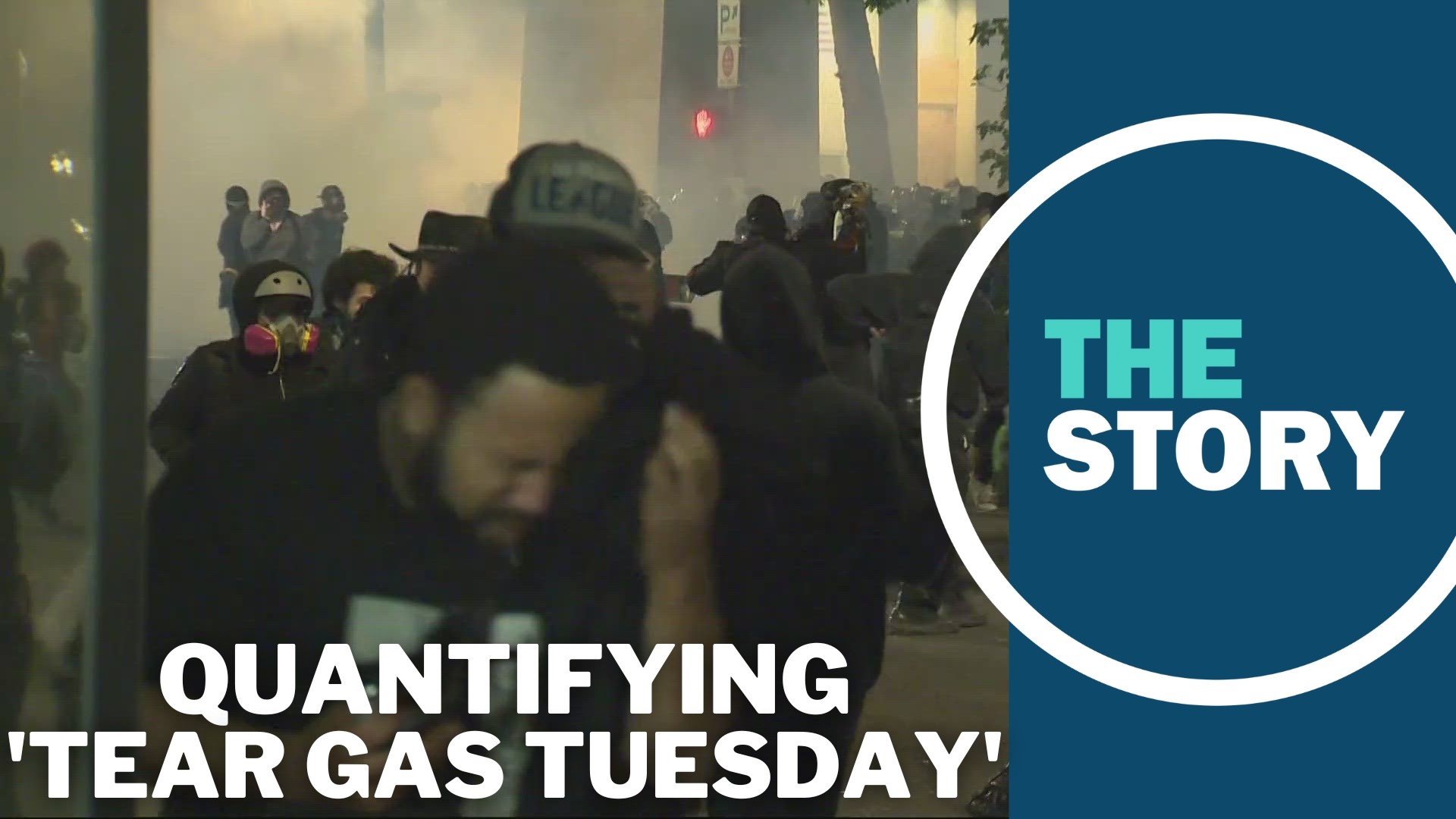PORTLAND, Ore. — It's been less than three years since racial justice protests sparked by the murder of George Floyd roiled Portland during the spring and summer of 2020 — but those years have been long ones, dominated by the COVID-19 pandemic and the struggle to emerge from its lingering impacts.
You'd be forgiven for forgetting some of the specifics of that long summer. If you have, here's a refresher.
Floyd died at the hands of a Minneapolis police officer in May of 2020. After video of the event went viral, it set off massive protests in cities throughout the country. Here in Portland, thousands of people marched peacefully — many others did not. It was a summer of clashes between demonstrators and law enforcement.
June 2 was the sixth straight night of protests in Portland, and it was one of many nights to come that saw things get particularly heated between protesters and Portland police.
KGW's Mike Benner was out reporting that night, catching video and sound of police munitions going off, protesters yelling and car horns honking.
"Just after 9:00, there was a skirmish between police and a splinter group of protesters," Benner reported. "It appears police used tear gas and flash bangs to disperse the rowdy crowd."

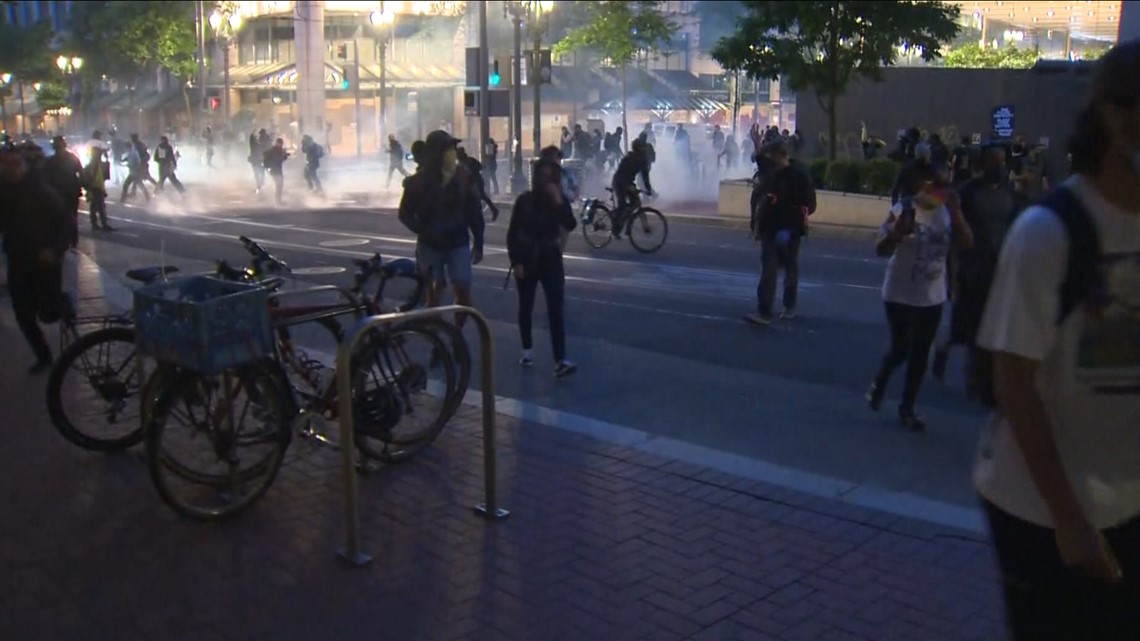
The night began with peaceful demonstrations, but clashes between law enforcement officers and smaller groups of rioters became more and more intense as the night went on.
Video captured Portland police vehicles speeding through an intersection where protesters were moving barricades, as people narrowly evaded being run down. Eventually the night devolved into an all-out battle between rioters and Portland police.
Portland police didn't hold back that night as they tried to get rid of the protesters — firing off flash bangs, using their vehicles as battering rams, even spray-painting protesters' vehicle to try and track people down later. But most of all, police indiscriminately deployed tear gas against the protesters; a lot of it. This is the night colloquially known as "Tear Gas Tuesday."
Even though the night became infamous for its choking chemical clouds, we're only now getting a better idea of how much tear gas was used.


Battlefield Portland
A new study from a group called Forensic Architecture modeled how much tear gas they estimate was deployed throughout the night in Portland on June 2, 2020. The London-based research firm typically looks into cases of suspected war crimes and human rights violations around the world. Forensic Architecture has also investigated Russian airstrikes in Ukraine and ethnic cleansing in Jerusalem.
But recently, researchers from the firm looked into the way that tear gas was used in Portland — and they found that Portland police deployed so much tear gas that concentrations in the air reached thousands of times above established safe levels in places.
Using videos from social media, news reports, public records and statements from people on the ground, researchers attempted to map out where tear gas — referred to in the report by the more specific term, CS gas — was deployed throughout the city and when.

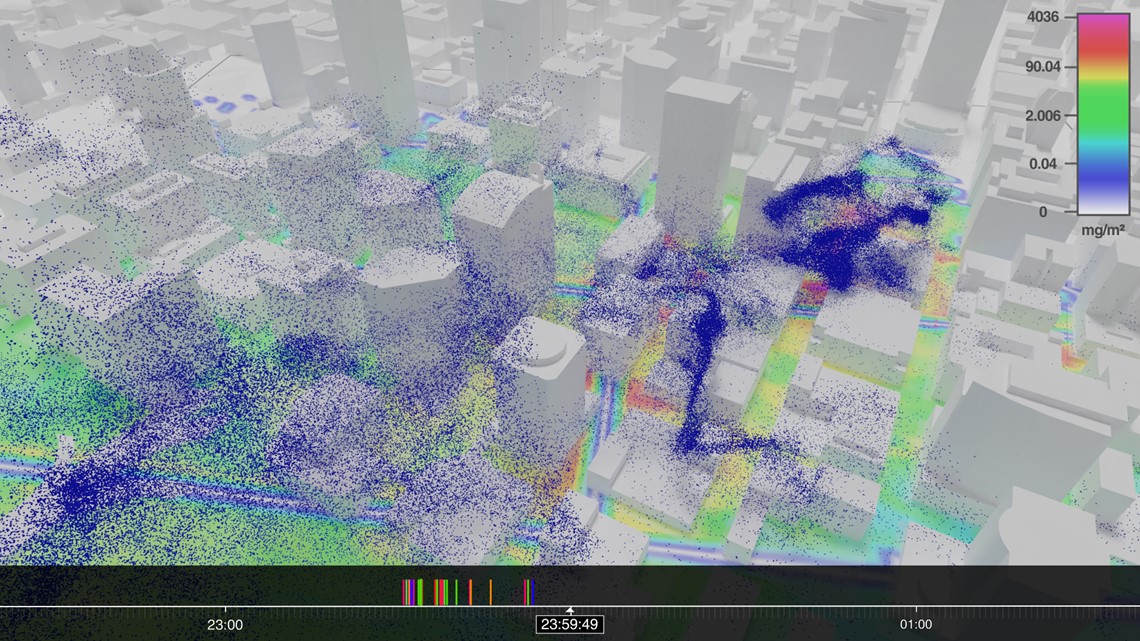
Forensic Architecture hoped to measure the concentration and spread of gas throughout the night.
"With weapons experts from the Omega Research Foundation, we identified different discharge and explosion patterns in videos from June 2," the firm said in a video describing its methodology. "These patterns allowed us to assign each munition to a munition type, rule out those which likely didn't carry any chemical agents, and estimate the minimum quantities of CS and OC in each munition type."
OC refers to oleoresin capsicum, or "pepper spray." Researchers took the discharge information and modeled out how much gas would have been present throughout the city. They reported finding at least 138 chemical munitions used across 25 blocks over the course of roughly 3.5 hours.
At the time, PPB was not required to track how many munitions it stockpiled or used, something that the Portland City Council mandated later.

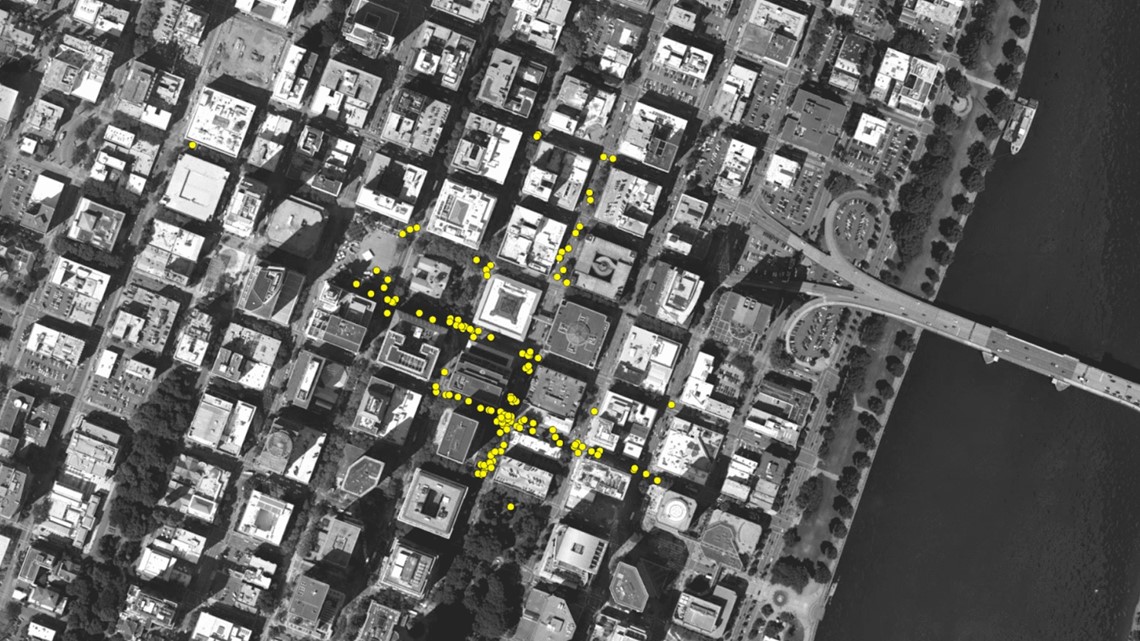
Forensic Architecture paired the data it gathered with weather conditions from that day to simulate how the gas would have spread through the air. Here's what they found:
"Concentrations of CS reached up to 67 mg per meter cubed. The federal Health and Safety Administration considers that 2 mg per meter cubed is immediately dangerous to life or health — a threshold known to the PPB, according to their own documents."
Some locations would have had concentrations far above safe levels for a total of 73 minutes, the study found.
"We measured airborne concentrations in a further 15 locations across downtown Portland. These included locations within the protest area, but also others hundreds of meters away," the firm continued. "The 2 mg threshold was exceeded in every location. In many locations, concentrations were recorded above 100 mg per meter cubed. The highest recorded concentration was 4,500 mg per meter cubed — more than 2,000 times the limit considered life threatening."

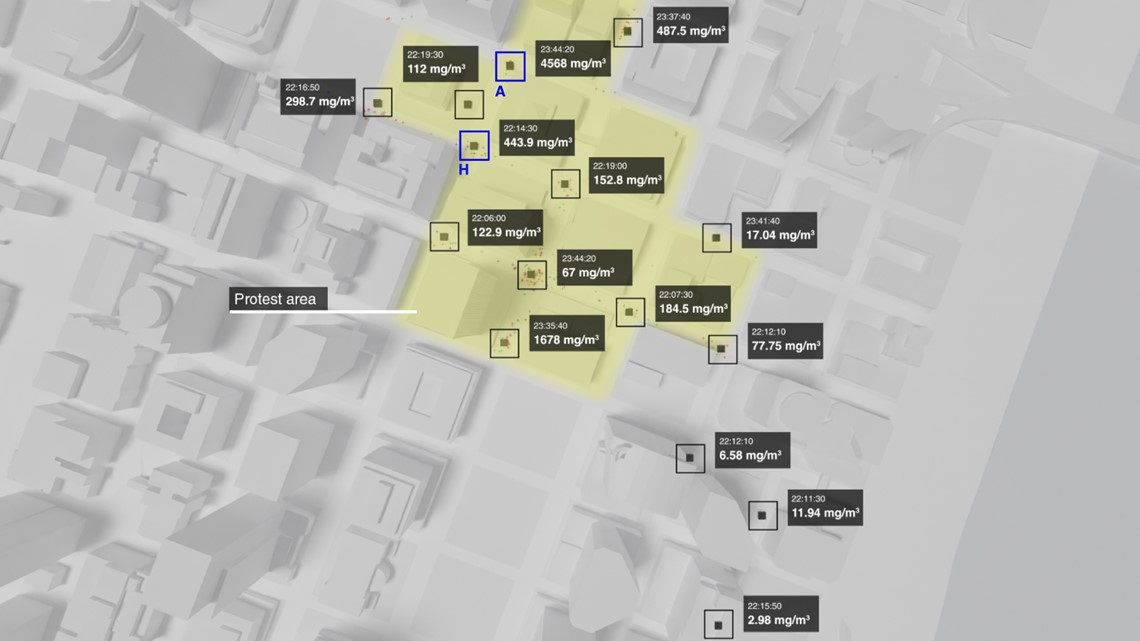
The downstream impacts
These chemicals in the air didn't just dissipate harmlessly after that, the report says. Instead they washed into the Willamette River, threatening marine life and farmland.
Portland's Bureau of Environmental Services later took a look at the city's storm water and sediment downtown. They did find elevated levels of the chemicals found in tear gas in city storm drains, but they reported that those levels dropped by the time they reached the river.
Forensic Architecture's report disagreed, based on their modeling of how the gas spread through the air.


As for the effects on humans, that's another story. There were many reports of adverse health conditions from tear gas — both among protesters and people who had nothing to do with them. Some were bystanders caught in the crossfire, or people who lived or worked near the site of the protests.
"It felt as if someone was giving you mouth-to-mouth resuscitation and blowing toxins into your lungs," one person told KGW. "It was that severe and direct ... and it has a burning sensation like never before."
Many women reported changes to their menstrual cycles after getting tear-gassed.
"My cycle would get much heavier," one woman said. "I would bleed profusely, the pain was extreme ... and I would get really bad headaches, which was something I didn't really get before."
For others, it was the lingering trauma of being caught in the facsimile of a warzone.
"I have many accounts of people being hurt around me, people doubling over in pain, throwing up," said another person. "It is mentally traumatizing because (when) I'm goin' places I can't not look over shoulder — when stuff hits the ground I jump."
Researchers at Kaiser Permanente Center for Health Research in Portland have been studying the effects of tear gas exposure on people in Portland. Two years ago, researchers surveyed more than 2,000 people about how tear gas had impacted their health. Ninety-four percent of respondents reported adverse health effects.
"What our research showed was that, you know, for people after they were exposed to tear gas, even when they left the vicinity and walked away, they were not having dissipation of those health impacts right away," said Britta Torgrimson-Ojerio, head researcher for the Kaiser study. "They were having burning eyes, itchy eyes, itchy skin, coughing, nausea, kind of in the immediate (aftermath). But these symptoms were lasting, for them, through days and even into weeks where people were having gastrointestinal issues — you know, lots of nausea.
"There were people that were having prolonged headaches, people that were continuing to have breathing issues, people reporting eye issues, dizziness. So, kind of a wide range across physiological symptoms — and then, of course, we had people reporting that they were having changes in their menstrual function. And that was a little bit of even longer-term."
Those reports directly contradicted what Portland police told the press about tear gas at the time.
"(It's) a substance that if you walk out of it, you really stop feeling effects right away," a PPB spokesperson said. "You'll have some residual effects that I've encountered it — I might get a little bit of an aftertaste. You're functional a lot faster, and you'll suffer a whole lot less long."
But the Kaiser researcher said that this new report corroborates what people were reporting about the health impacts after being exposed to tear gas.
"We did know that people were exposed. And we asked people to report on the number of days that they were exposed, but we had no way of establishing what types of concentrations they would have been exposed to — and we were also limited at that time, not even understanding which exact chemical agents they were exposed to," said Torgrimson-Ojerio. "So really what this study is showing us is kind of that range and what the exposure is, and ultimately showing that, based on OSHA standards, the concentrations that were being deployed in this scenario well exceed what would be considered a safe use — and that in fact that these levels, these concentrations are known to cause health issues for people."
Gas, interrupted
KGW asked Portland police about the new study. A spokesperson said that they are still dealing with pending litigation and can't comment.
Just a few days after the night that Forensic Architecture studied, protesters sued the city over PPB's liberal use of tear gas. Mayor Ted Wheeler repeatedly directed Portland police not to use it, and a judge later barred PPB from using it except for circumstances in which a person's life or safety is at risk. The judge concluded that police had used gas against peaceful protesters.
But months after that ruling, the judge found that PPB was still violating the order. The city ultimately settled with protesters, paying them $250,000.
That summer, much of the attention paid to the use of tear gas and other less-lethal munitions drifted from Portland police to federal law enforcement, as a multi-agency crackdown by the Trump administration made the federal Mark O. Hatfield Courthouse the central focus of nightly protests in the city.
Clashes between protesters and Portland police went on well into 2021, but they gradually became smaller-scale affairs — skirmishes between police and a core of anarchists and other antifascist activists. PPB's use of tear gas continued, but again under more limited circumstances.
These days, PPB cites some recent restrictions on the use of tear gas and other crowd control munitions, combined with limited staffing, as top reasons why officers often don't respond to illegal street racing events. But even under tighter state laws, police are allowed to use tear gas in events that legally constitute a riot when an officer reasonably believes it "is necessary to terminate and prevent furtherance of the riotous behavior."

